Our "Turk" burner burns raw glycerine by-product from the biodiesel process. It takes about 45 minutes to heat 60 litres of WVO for biodiesel processing and uses 700 ml of by-product to do it.
It's made out of a sawn-off 4" fire-extinguisher with a round bottom, a stainless steel mug (the wick), a curry can and a lid, and some copper piping.
The fuel reservoir is salvaged from a dead kerosene space heater, the "squirrel-cage" blower fan from a dead kerosene water heater. 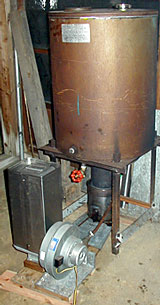 The outlet (lid) of the fuel tank has an outlet valve that keeps a constant level of fuel in the reservoir below; connected by a 1/4" copper pipe, the same fuel level is maintained in the burner. This solves the problem of continuous fuel feeding.
The outlet (lid) of the fuel tank has an outlet valve that keeps a constant level of fuel in the reservoir below; connected by a 1/4" copper pipe, the same fuel level is maintained in the burner. This solves the problem of continuous fuel feeding.
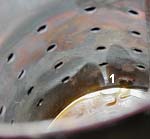 To use the burner, switch on the fuel tap to prime it with fuel; wait until the fuel level stabilises just below the fuel inlet (left, 1). You might have to use some planks under the burner unit to get the right level.
To use the burner, switch on the fuel tap to prime it with fuel; wait until the fuel level stabilises just below the fuel inlet (left, 1). You might have to use some planks under the burner unit to get the right level.
Soak a tissue in biodiesel, light it and drop it into the burner.
Turn on the fan.
Place the stainless steel wick in the top of the burner.
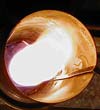
The by-product begins to burn

Full burn
|
And wait... It won't burn properly until the whole inner burner unit is hot, and it takes about five minutes or longer. Meanwhile the tissue wicks up more fuel and keeps burning, but the by-product itself doesn't burn until it's hot enough.
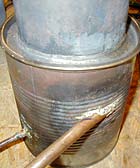 You'll know when it's working properly: the flame covers the whole surface of the fuel and roars up in a spiral, spewing out the top of the burner, and the whole inner unit gets red-hot.
You'll know when it's working properly: the flame covers the whole surface of the fuel and roars up in a spiral, spewing out the top of the burner, and the whole inner unit gets red-hot.
The disadvantages are that while the burner burns for long enough to pre-heat the oil, it then gets so gunged up with sticky black stuff (mostly soap) that it chokes itself to death and has to be cleaned out before you can continue.
Another disadvantage is that it's not a clean burn, it smokes, especially towards the end of the burn when it's trying to combust the soap.
A 2" air-inlet pipe like Mac's (diagram above) would be an improvement, but we don't think any Turk-type burner can get hot enough to burn biodiesel by-product cleanly and without getting gunged up. 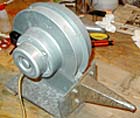 The elusive goal. Prof. Michael Allen thinks it takes a burning temperature in excess of 1,000 deg C (1,800 deg F) "and you will probably need a mean residence time in the Hot Box of about 5 seconds". And perhaps pre-heating and atomisation as well. See Burning glycerine
The elusive goal. Prof. Michael Allen thinks it takes a burning temperature in excess of 1,000 deg C (1,800 deg F) "and you will probably need a mean residence time in the Hot Box of about 5 seconds". And perhaps pre-heating and atomisation as well. See Burning glycerine
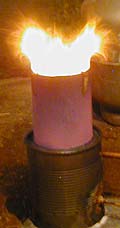
Red-hot
|
We used the Turk burner a few times, but replaced it with a kerosene pressure stove made in India, which burns pure biodiesel.
We've found that Mother Earth News waste oil heaters also won't burn the by-product for long before coking up. 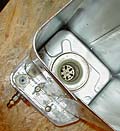 We'd hoped a modified version using a forced air-supply, which burns much hotter, would solve the problem, but it didn't, though it's excellent with a bioheating oil we make, similar to biodiesel but much cheaper. See Journey to Forever's forced-air biofuel heater
We'd hoped a modified version using a forced air-supply, which burns much hotter, would solve the problem, but it didn't, though it's excellent with a bioheating oil we make, similar to biodiesel but much cheaper. See Journey to Forever's forced-air biofuel heater
Anyway, if you want to tinker with Turk burners and the glycerine by-product of biodiesel, our Turk burner is a good place to start -- it works, maybe you can get it to work better. If you succeed, please let us know. Both the bioheating oil and biodiesel work well in Turk burners, and so does the separated FFA from the by-product (see Separating the glycerine). There are other ways of re-using the by-product effectively. See Glycerine and biogas
Biofuels
En español -- Biocombustibles, biodiesel
Biofuels Library
Biofuels supplies and suppliers
Biodiesel
Make your own biodiesel
Mike Pelly's recipe
Two-stage biodiesel process
FOOLPROOF biodiesel process
Biodiesel processors
Biodiesel in Hong Kong
Nitrogen Oxide emissions
Glycerine
Biodiesel resources on the Web
Do diesels have a future?
Vegetable oil yields and characteristics
Washing
Biodiesel and your vehicle
Food or fuel?
Straight vegetable oil as diesel fuel
Ethanol
Ethanol resources on the Web
Is ethanol energy-efficient?
 The outlet (lid) of the fuel tank has an outlet valve that keeps a constant level of fuel in the reservoir below; connected by a 1/4" copper pipe, the same fuel level is maintained in the burner. This solves the problem of continuous fuel feeding.
The outlet (lid) of the fuel tank has an outlet valve that keeps a constant level of fuel in the reservoir below; connected by a 1/4" copper pipe, the same fuel level is maintained in the burner. This solves the problem of continuous fuel feeding. To use the burner, switch on the fuel tap to prime it with fuel; wait until the fuel level stabilises just below the fuel inlet (left, 1). You might have to use some planks under the burner unit to get the right level.
To use the burner, switch on the fuel tap to prime it with fuel; wait until the fuel level stabilises just below the fuel inlet (left, 1). You might have to use some planks under the burner unit to get the right level.

 You'll know when it's working properly: the flame covers the whole surface of the fuel and roars up in a spiral, spewing out the top of the burner, and the whole inner unit gets red-hot.
You'll know when it's working properly: the flame covers the whole surface of the fuel and roars up in a spiral, spewing out the top of the burner, and the whole inner unit gets red-hot. The elusive goal. Prof. Michael Allen thinks it takes a burning temperature in excess of 1,000 deg C (1,800 deg F) "and you will probably need a mean residence time in the Hot Box of about 5 seconds". And perhaps pre-heating and atomisation as well. See Burning glycerine
The elusive goal. Prof. Michael Allen thinks it takes a burning temperature in excess of 1,000 deg C (1,800 deg F) "and you will probably need a mean residence time in the Hot Box of about 5 seconds". And perhaps pre-heating and atomisation as well. See Burning glycerine
 We'd hoped a modified version using a forced air-supply, which burns much hotter, would solve the problem, but it didn't, though it's excellent with a bioheating oil we make, similar to biodiesel but much cheaper. See Journey to Forever's forced-air biofuel heater
We'd hoped a modified version using a forced air-supply, which burns much hotter, would solve the problem, but it didn't, though it's excellent with a bioheating oil we make, similar to biodiesel but much cheaper. See Journey to Forever's forced-air biofuel heater Mac's Turk burner plans
Mac's Turk burner plans